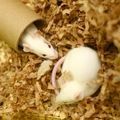Understanding Animal Research With Human Samples

In this post we hear from John Meredith, Head of Education and Outreach at Understanding Animal Research.
He tells us more about the use of human samples and animal research.
Why does some biobanked human tissue end up in animals?
It’s a fair question, even leaving aside the ethics of using animals for human medical research (more about that later). After all, aren’t animals and humans too different for it to make sense? Sinister images of Dr Moreau and other outrages against nature float into the mind’s eye.
In fact, the study of human tissue in animal models has a long and distinguished history. Progress in tackling cancer has long depended on the ability to model human tumour growths in mice, for example. Most biobanked tissue is destined for non-animal research - sometimes even for new technologies that can replace some animals in research. However, it is still invaluable occasionally to transfer human material into another species, a technique known as a xenograft.
How does research with animals and humans work?
The science works because, despite the many differences between humans and other species, the relationship at the cellular level is extremely close. You share more than 90% of your genes with Mus musculus musculus, the white mouse most often used for medical research. The closeness of the relationship means we can observe effects taking place in a mouse, rat, fish or bird that are likely to be strongly similar to the effects in humans. Not exactly the same, of course, but close enough.
The 2018 Nobel Prize for Physiology and Medicine is just one example, awarded for a breakthrough study in the immunological treatment of cancer in humans. The treatment works by using the patient’s own immune system to attack the cancer. Furthermore, it has proven to be extremely effective, opening the door to a whole new range of cancer therapies. It could only developed by experimenting with the immune responses of mice.
How do we determine when to use animals in research?
That last point is an important one. Regulation of animal studies in medicine is extremely strict, as strict as the regulation of human tissue or volunteers. The Home Office must be satisfied that the science is significant enough to justify the use of animals and that there is no other way the research could be done. If there is an alternative, human tissue in a lab for example, that has to be used. You can rest assured that any donated tissue will only be used in animal models in the most carefully regulated circumstances. Also, that it will only be used for the most serious medical research.
As time goes by we hope and expect that fewer and fewer animals will be needed for medical research. Some new technologies, like organs on a chip which use donated human tissue, have replaced some animal work already. A lot of work is being done to use simpler animals and minimise suffering or distress. You may be surprised that, after mice, the zebra fish is the second most commonly used animal in the UK. There is still so much to learn in terms of disease and the functioning of human bodies. So, we are going to sometimes need to resort to animal studies if we hope to make progress against formidable conditions, such as Alzheimer’s or Multiple Sclerosis. And for these animal models to work, we will sometimes also need to use human tissue.
About Understanding Animal Research
Understanding Animal Research is a not-for-profit organisation that explains why animals are used in medical and scientific research funded by their members who include universities, professional societies, industry and charities. UAR’s aim is to achieve a broad understanding of the humane use of animals in medical, veterinary, scientific and environmental research in the UK.
